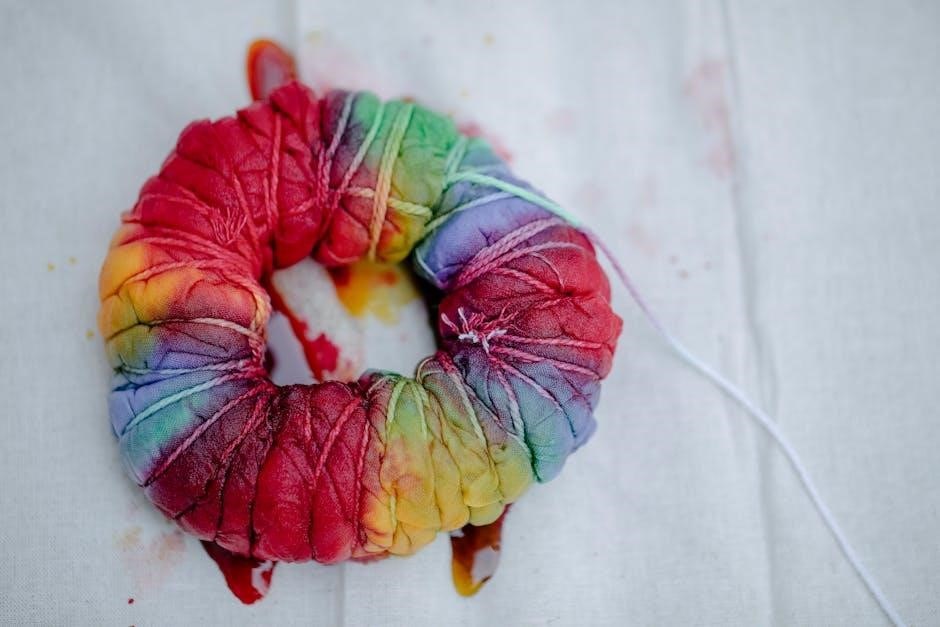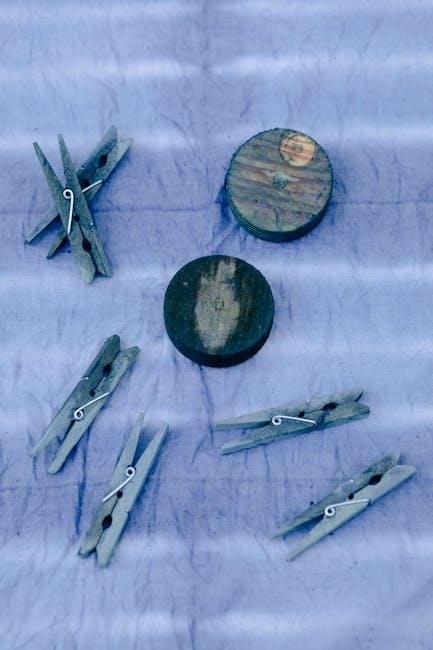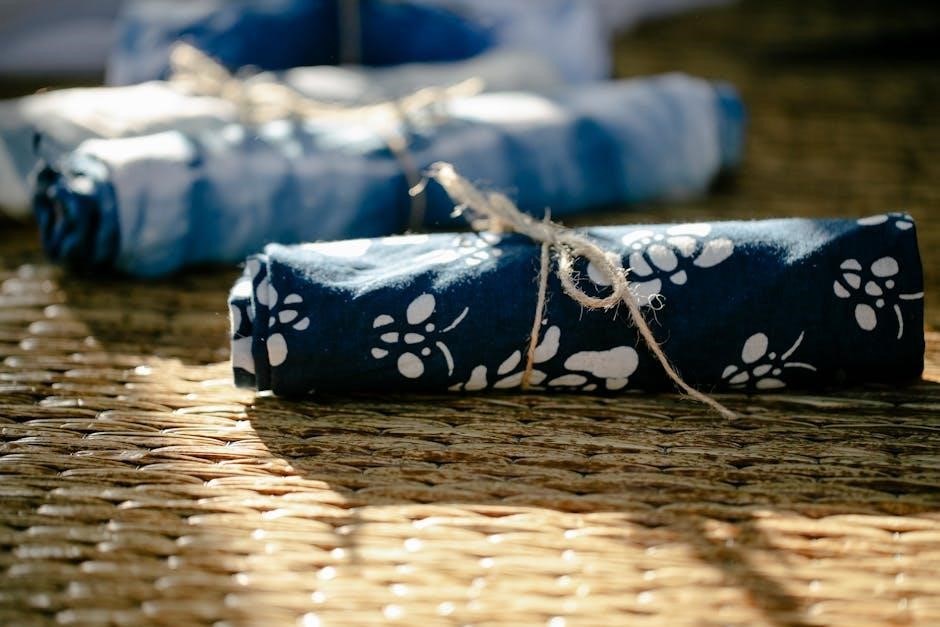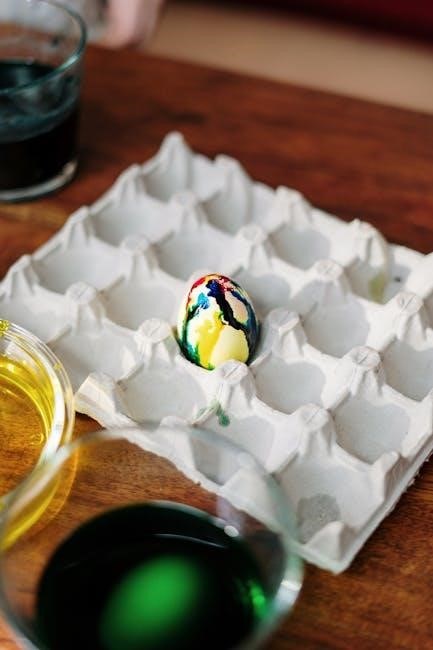Tie-dye washing is an art that requires careful attention to preserve vibrant colors and patterns. Proper techniques ensure longevity, while tips like cold water rinsing and using gentle detergents help maintain fabric quality and prevent fading.
1.1 Understanding the Basics of Tie-Dye Care
Understanding the basics of tie-dye care is essential to maintain the vibrant colors and unique patterns of your garments. Tie-dye fabrics are sensitive to washing methods, and improper care can lead to fading or color bleeding. The first step is to rinse excess dye thoroughly before washing, as loose dye particles can transfer to other clothes. Cold water is recommended for rinsing and washing to prevent colors from fading. Additionally, using a mild detergent or specialized products like Synthrapol can help preserve the dye and fabric quality. It’s also important to avoid fabric softeners, as they can interfere with the dye’s adherence to the fabric. By following these fundamental care practices, you can ensure your tie-dye items remain bright and intact for a long time.
Regular maintenance involves gentle handling and avoiding harsh chemicals, ensuring your tie-dye creations stay vibrant and durable.
1.2 Importance of Proper Washing Techniques
Proper washing techniques are crucial to preserve the vibrant colors and intricate patterns of tie-dye fabrics. Improper washing can lead to color fading, bleeding, or damage to the fabric. Rinsing excess dye before washing is essential to prevent loose particles from affecting other clothes. Using cold water helps maintain color intensity, while hot water can cause colors to bleed or fade. Additionally, washing tie-dye items separately from other laundry ensures no cross-color contamination. Avoiding fabric softeners and harsh detergents is also vital, as they can strip away the dye or damage the fabric. Turning garments inside out before washing further protects the design. By adhering to these guidelines, you can maintain the integrity and beauty of your tie-dye items for years to come.
Proper care not only extends the life of your tie-dye but also ensures it remains a vibrant and unique piece in your wardrobe.

Preparation for Washing Tie-Dye Items
Preparation is key to preserving tie-dye colors and patterns. Rinse excess dye with cold water, remove rubber bands carefully, and check for colorfastness. Using white vinegar can enhance color preservation before washing.
2.1 Rinsing Excess Dye Before Washing
Rinsing excess dye before washing is a crucial step to prevent color bleeding and fading. Start by turning the tie-dye item inside out to protect the design. Rinse under cold running water, gently agitating the fabric to remove loose dye particles. Continue rinsing until the water runs mostly clear, ensuring no residual dye remains. For darker or more vibrant colors, consider soaking the item in a mixture of cold water and white vinegar for about 30 minutes to enhance colorfastness. Avoid using hot water during this step, as it can set excess dye and lead to premature fading. Once the water runs clear, remove excess moisture without wringing or twisting the fabric. This step ensures the dye is stabilized, making the washing process safer and more effective. Proper rinsing sets the foundation for maintaining the integrity and vibrancy of your tie-dye design.
2.2 Removing Rubber Bands Safely
Removing rubber bands from tie-dye items requires care to avoid distorting the fabric or damaging the design. After rinsing excess dye, gently cut the rubber bands with scissors rather than pulling them off, as this can stretch or misshape the fabric. Work slowly to prevent pulling or tugging, which might disrupt the folded or twisted pattern. Once the bands are removed, carefully unfold the fabric to reveal the design. Avoid snapping or yanking the bands, as this could cause stress on the material. After removing the bands, rinse the item again under cold water to ensure no loose dye remains. Patience is key, as improper removal can lead to uneven patterns or color bleeding. By handling the fabric gently, you preserve the integrity of your tie-dye design and ensure vibrant, long-lasting results.
2.3 Checking for Colorfastness
Checking for colorfastness is essential to ensure your tie-dye design retains its vibrancy and doesn’t bleed or fade excessively. Before washing, perform a simple test by dampening a small, inconspicuous area of the fabric and gently blotting it with a white paper towel. If significant color transfers, the dyes may not be fully set, and extra precautions are needed. To improve colorfastness, soak the item in a mixture of cold water and white vinegar for about 30 minutes before washing. This helps lock the colors into the fabric. Additionally, avoid using hot water initially, as it can cause colors to bleed. Always check the dye instructions for specific recommendations, as some dyes may require additional setting steps. Ensuring colorfastness prevents unwanted color transfer during washing and preserves the integrity of your tie-dye design for a longer period.

2.4 Using White Vinegar for Color Preservation

White vinegar is a natural and effective way to preserve the colors of your tie-dye items. By soaking your fabric in a mixture of equal parts white vinegar and cold water for about 30 minutes, you can help lock in the dyes and improve colorfastness. This step is particularly useful after the initial rinse and before the first wash. The acidity in vinegar helps balance the pH of the fabric, preventing the dyes from bleeding or fading. It also acts as a mild cleanser, removing any residual dye particles without damaging the fabric. For best results, avoid adding vinegar during the washing machine cycle, as it may interfere with detergent effectiveness. Instead, use it as a pre-treatment soak to ensure your tie-dye remains vibrant and colorful for a longer period. This simple, eco-friendly method is a great way to maintain the quality and appearance of your tie-dye creations.

The Washing Process
The washing process for tie-dye items involves gentle cycles and cold water to prevent color fading. Use a mild detergent like Synthrapol to remove excess dye without damaging fabrics. Wash tie-dye separately and avoid high heat for optimal color preservation.
3.1 Washing Machine Instructions
When using a washing machine for tie-dye items, start by rinsing excess dye under cold water until it runs clear. Place the item in the machine alone to prevent color transfer. Use cold water and a mild detergent like Synthrapol, which helps retain colors. Avoid fabric softeners and harsh chemicals. Select a gentle cycle with low agitation to protect the fabric and design. After washing, remove the item promptly to prevent fading. For the first few washes, consider washing tie-dye items separately or with similar colors. High heat should be avoided in both washing and drying to maintain vibrancy. Following these steps ensures your tie-dye remains bright and intact for years to come.
3.2 Hand-Washing Tie-Dye Items
Hand-washing is a gentle and effective method for cleaning tie-dye items, especially for delicate fabrics or newly dyed garments. Start by filling a basin with cold water and adding a small amount of mild detergent. Gently submerge the tie-dye item, turning it inside out to protect the design. Allow it to soak for about 15-20 minutes to loosen any excess dye. Use your hands to agitate the water softly, avoiding vigorous movements that could damage the fabric or cause colors to bleed. Rinse thoroughly under cold running water until the water runs clear. Gently squeeze out excess moisture without wringing or twisting the fabric. Lay the item flat to air dry, away from direct sunlight. For extra color preservation, soak the item in a mixture of cold water and white vinegar for 30 minutes before rinsing. This method ensures vibrant colors and a long-lasting tie-dye design.
3.3 Washing Tie-Dye Separately
Washing tie-dye items separately is essential to protect both the garment and other clothes from dye bleeding. For the first few washes, tie-dye items should be washed alone to remove excess dye that may still be present. This prevents unwanted color transfer to other fabrics. When washing tie-dye separately, use cold water and a mild detergent to preserve the vibrancy of the colors. Place the item inside out to shield the design from friction and abrasion. Avoid mixing tie-dye with heavily soiled laundry or dark-colored items, as this can compromise the integrity of the dyes. For added precaution, consider using a color-catching sheet in the wash to absorb any loose dye particles. After the initial washes, you can gradually integrate tie-dye items with similar colors, but always prioritize cold water and gentle cycles to maintain their unique patterns and hues.
3.4 Choosing the Right Detergent
Choosing the right detergent is crucial for maintaining the vibrancy and integrity of tie-dye items. Opt for a mild, pH-neutral detergent that is designed for color preservation, such as Synthrapol or similar products. These detergents are specifically formulated to prevent dye from bleeding or fading while effectively cleaning the fabric. Avoid harsh chemicals, bleach, or fabric softeners, as they can damage the dyes and weaken the fabric. For hand-washing, a gentle hand-wash detergent is ideal, as it minimizes color loss and preserves the texture of the material. When using a washing machine, ensure the detergent is free of enzymes and optical brighteners, which can degrade the dye over time. Always follow the instructions on the detergent label and use the recommended amount to avoid over-saturating the fabric. By selecting the right detergent, you can enjoy your tie-dye items for years while keeping their colors bright and patterns intact.
3.5 Water Temperature Guidelines
Water temperature plays a significant role in maintaining the vibrancy and integrity of tie-dye items. For the first wash, cold water is highly recommended to rinse out excess dye and prevent color bleeding. Subsequent washes can use slightly warmer water, but hot water should be avoided as it can cause colors to fade rapidly. When hand-washing, always use cold water to gently cleanse the fabric without damaging the dye. For machine washing, a cold or warm water setting is ideal, ensuring the colors remain vivid. Turning garments inside out before washing can also protect the tie-dye patterns from friction and fading. Avoid using hot water, especially in the initial washes, as it can weaken the bond between the dye and fabric. By adhering to these temperature guidelines, you can preserve the beauty and longevity of your tie-dye creations.
3.6 Drying Tie-Dye Items
Drying tie-dye items requires careful consideration to maintain their color vibrancy and fabric integrity. Air drying is the most recommended method, as it prevents color fading and distortion. Lay the item flat on a clean, dry surface or hang it upside down to avoid stretching. Avoid direct sunlight, as UV rays can cause colors to fade over time. If using a dryer, opt for a low heat setting and remove the item while it is still slightly damp to air-dry the remainder. High heat can weaken the dye bond and lead to premature fading. For delicate fabrics, air drying is essential to preserve the tie-dye pattern. Additionally, consider adding a rinse with white vinegar before drying to enhance colorfastness. Always dry tie-dye items separately from other laundry to prevent potential dye transfer. By following these drying guidelines, you can ensure your tie-dye creations remain vibrant and intact for years to come.

Care and Maintenance
Regular care ensures tie-dye items retain their vibrancy and durability. Wash sparingly, using cold water and gentle detergents. Store in a cool, dry place, away from direct sunlight. Avoid fabric softeners and harsh chemicals. Turn items inside out before washing to protect patterns. For added color preservation, soak in white vinegar solution periodically. Proper storage and maintenance routines will keep your tie-dye creations looking fresh and vibrant over time.
4.1 Washing Frequency
Tie-dye items should not be washed excessively to preserve their vibrant colors and patterns. Spot cleaning is recommended for minor stains to avoid unnecessary washing. When washing is necessary, use cold water and a gentle detergent to prevent color fading. Turn garments inside out to protect the tie-dye design from friction and abrasion. Avoid washing tie-dye items with heavily soiled or dark-colored laundry to minimize the risk of color transfer. For the first few washes, consider washing tie-dye items separately from other clothes to ensure excess dye is fully removed. After the initial washes, tie-dye can be laundered with similar colors using a mild detergent. Air drying or using a low-heat setting is recommended to maintain color intensity. To further preserve colors, soak tie-dye items in a mixture of white vinegar and cold water periodically. Proper washing frequency and techniques will help maintain the freshness and vibrancy of your tie-dye creations over time.

4.2 Storing Tie-Dye Items
Proper storage is essential to maintain the quality and vibrancy of tie-dye items. Store them in a cool, dry place away from direct sunlight, which can cause colors to fade. Fold items neatly to avoid stretching or creasing, as hanging can lead to distortion of the fabric. Use breathable storage bags or cloth covers to protect against dust and moisture. Avoid storing tie-dye items in plastic bags, as they can trap humidity and potentially damage the fabric. Before storing, ensure the item is completely clean and dry, as dirt or moisture can set in and cause stains over time. For long-term storage, consider placing items in a protective box with tissue paper to maintain their shape. Regularly inspect stored items to ensure they remain in good condition. By following these storage tips, you can preserve the beauty and longevity of your tie-dye creations.
4.3 Avoiding Fabric Softeners
Fabric softeners should be avoided when washing tie-dye items, as they can leave a residue on the fabric that may dull colors or cause dye to bleed. These products are designed to reduce static cling and make fabrics feel softer, but they can interfere with the dye’s ability to bind to the fabric, leading to fading or discoloration. Instead of fabric softeners, opt for gentle, pH-neutral detergents specifically designed for colored or delicate fabrics. These detergents are less likely to strip the dye from the fabric, preserving the vibrancy of the tie-dye design. Additionally, avoid using bleach or harsh chemicals, as they can damage the fabric and weaken the color bonds. For the best results, always check the detergent’s ingredient list to ensure it is free from softening agents that could harm your tie-dye creations.
4.4 Professional Cleaning Options
For delicate or heavily dyed tie-dye items, professional cleaning services may be the best option to ensure colors remain vibrant and patterns intact. Professional cleaners specialize in handling unique fabrics and dyes, using tailored techniques to preserve the integrity of the design. They often employ gentle, pH-neutral detergents and specialized equipment to prevent color bleeding or fading. Additionally, some cleaners offer hand-washing services, which are ideal for intricate or sensitive tie-dye pieces. If you’re unsure about the best way to care for your tie-dye item, especially if it’s made from silk, rayon, or another delicate material, consulting a professional can provide peace of mind. Many professional cleaners also offer advice on future care to maintain the longevity of your tie-dye creations. This option is particularly recommended for high-value or sentimental items that require extra attention and care.

Troubleshooting Common Issues
Tie-dye washing can sometimes lead to color fading, bleeding, or stains. Addressing these issues promptly ensures vibrant results. Solutions include vinegar soaks, gentle detergents, and separate washing to maintain color integrity and fabric quality.
5.1 Addressing Color Fading
Color fading is a common issue with tie-dye items, especially after repeated washing. To combat this, rinse tie-dye garments thoroughly before washing and use cold water, which helps retain vibrant colors. Adding white vinegar to the rinse water can enhance colorfastness. Avoid using hot water or harsh detergents, as they can strip the dye. For hand-washed items, gently swish in cold water with a mild detergent. If fading occurs, consider re-dyeing or touching up the design. Washing tie-dye separately from other clothes prevents cross-color bleeding and protects the integrity of the pattern. Air-drying or using low heat settings when drying also helps preserve colors. Regular care practices, like turning garments inside out before washing, can further reduce fading. By following these steps, you can maintain the brightness and longevity of your tie-dye creations.
5.2 Fixing Color Bleeding
Color bleeding is a common challenge with tie-dye items, especially during the initial washes. To address this, rinse the garment thoroughly under cold water before washing to remove excess dye. Adding white vinegar to the rinse water can help lock in colors and reduce bleeding; When washing, use a mild detergent specifically designed for dyed fabrics, such as Synthrapol, which prevents dye from transferring to other clothes. Avoid using fabric softeners, as they can weaken the bond between the dye and fabric, leading to further bleeding. Washing tie-dye items separately from other laundry or with similar colors minimizes the risk of cross-color transfer. For persistent bleeding, soak the garment in cold water with a small amount of detergent before washing. Regular care practices, like turning items inside out and using cold water, can also help prevent future bleeding and maintain the integrity of your tie-dye designs.
5.3 Removing Dye Stains
Removing dye stains from tie-dye items requires gentle yet effective methods to prevent damaging the fabric or fading the design. Start by rinsing the stained area under cold water to remove loose dye particles. Soak the garment in a mixture of cold water and white vinegar for about 30 minutes to help break down the dye. Gently scrub the stained area with a soft brush or your hands, then rinse thoroughly. For stubborn stains, apply a small amount of mild detergent, like Synthrapol, directly to the affected area and let it sit for 10-15 minutes before washing. Wash the item separately in cold water using a gentle cycle to avoid transferring dye to other clothes. Avoid using hot water or harsh chemicals, as they can set the stain or damage the fabric. Repeat the process if the stain persists, ensuring not to dry the item until the stain is fully removed to prevent it from setting permanently.
Properly washing and caring for tie-dye items is essential to preserve their vibrant colors and unique patterns. By following the outlined steps, such as rinsing excess dye, using cold water, and avoiding harsh chemicals, you can enjoy your tie-dye creations for years. Regular maintenance, like storing items separately and washing them inside out, further ensures their longevity. Remember, tie-dye fabrics are delicate, so gentle handling is key. With the right techniques and attention to detail, your tie-dye pieces will remain bright and intact, becoming cherished additions to your wardrobe. Always prioritize cold water, mild detergents, and air drying to maintain the integrity of the fabric and dye. By adhering to these care guidelines, you can keep your tie-dye items looking fresh and vibrant wash after wash.
